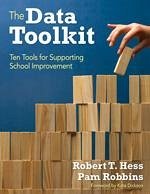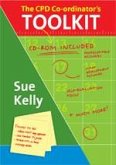- Broschiertes Buch
- Merkliste
- Auf die Merkliste
- Bewerten Bewerten
- Teilen
- Produkt teilen
- Produkterinnerung
- Produkterinnerung
How to accelerate analysis into action Using data for school improvement is a key goal of Race to the Top, therefore now is the time to make data-driven school improvement a priority. However, many educators are drowning in data. Boost your professional learning community's ability to translate data into action with this newest book from Robert T. Hess and Pam Robbins. The Data Toolkit provides ten easy-to-use tools that don't require statistical expertise, can be implemented in a timely manner, and facilitate problem-solving at classroom, school, and district levels. These proven methods help…mehr
Andere Kunden interessierten sich auch für
![The Cpd Co-Ordinator′s Toolkit The Cpd Co-Ordinator′s Toolkit]() Sue CoxThe Cpd Co-Ordinator′s Toolkit208,99 €
Sue CoxThe Cpd Co-Ordinator′s Toolkit208,99 €![Running a Nurture Group Running a Nurture Group]() Simon BishopRunning a Nurture Group249,99 €
Simon BishopRunning a Nurture Group249,99 €![The Quest For Compatibility & the Demise of Divorce The Quest For Compatibility & the Demise of Divorce]() Benjamin R. KuglerThe Quest For Compatibility & the Demise of Divorce38,99 €
Benjamin R. KuglerThe Quest For Compatibility & the Demise of Divorce38,99 €![Taking the Reins Taking the Reins]() Peter D EckelTaking the Reins99,99 €
Peter D EckelTaking the Reins99,99 €![When the Pot Boils When the Pot Boils]() David A PaulWhen the Pot Boils113,99 €
David A PaulWhen the Pot Boils113,99 €![The Study Skills Toolkit for Students with Dyslexia The Study Skills Toolkit for Students with Dyslexia]() Monica GribbenThe Study Skills Toolkit for Students with Dyslexia144,99 €
Monica GribbenThe Study Skills Toolkit for Students with Dyslexia144,99 €![Misunderstood Misunderstood]() Allyson BlytheMisunderstood19,99 €
Allyson BlytheMisunderstood19,99 €-
-
-
How to accelerate analysis into action Using data for school improvement is a key goal of Race to the Top, therefore now is the time to make data-driven school improvement a priority. However, many educators are drowning in data. Boost your professional learning community's ability to translate data into action with this newest book from Robert T. Hess and Pam Robbins. The Data Toolkit provides ten easy-to-use tools that don't require statistical expertise, can be implemented in a timely manner, and facilitate problem-solving at classroom, school, and district levels. These proven methods help educators: - Frame the questions - Drive the conversation - Engage in productive reflection - Uncover understandings - Create a data-driven plan - Achieve and monitor results Written in an educator-friendly format each chapter contains instructions on using the tool, a sample scenario, and examples-practical tools that will help your PLC be the best it can be. Also included are case studies that show how data teams, PLCs, and individual teachers have used the book's methods in their own settings. The culminating school improvement mapping tool guides the team through designing an action plan focused on increasing student learning and achievement outcomes.
Hinweis: Dieser Artikel kann nur an eine deutsche Lieferadresse ausgeliefert werden.
Hinweis: Dieser Artikel kann nur an eine deutsche Lieferadresse ausgeliefert werden.
Produktdetails
- Produktdetails
- Verlag: Sage Publications, Inc.
- Artikelnr. des Verlages: B92978P
- Seitenzahl: 160
- Erscheinungstermin: 1. Dezember 2011
- Englisch
- Abmessung: 286mm x 220mm x 15mm
- Gewicht: 458g
- ISBN-13: 9781412992978
- ISBN-10: 1412992974
- Artikelnr.: 34567882
- Herstellerkennzeichnung
- Libri GmbH
- Europaallee 1
- 36244 Bad Hersfeld
- gpsr@libri.de
- Verlag: Sage Publications, Inc.
- Artikelnr. des Verlages: B92978P
- Seitenzahl: 160
- Erscheinungstermin: 1. Dezember 2011
- Englisch
- Abmessung: 286mm x 220mm x 15mm
- Gewicht: 458g
- ISBN-13: 9781412992978
- ISBN-10: 1412992974
- Artikelnr.: 34567882
- Herstellerkennzeichnung
- Libri GmbH
- Europaallee 1
- 36244 Bad Hersfeld
- gpsr@libri.de
Rob Hess is a practicing superintendent with 10 years of experience as a secondary teacher. He has been an administrator at the high school, middle school, and K-8 levels and served in the central office as a Student Achievement Leader. In 2003 he founded Breakthrough Schools, a grass roots network of educators dedicated to helping schools and districts achieve breakthrough school improvement results. He earned his doctorate from the University of Oregon and has taught classes at the University of Oregon, Oregon State University, Willamette University, and Lewis & Clark College on the following subjects: teacher leadership, professional development for administrators, priority leadership, school improvement planning, data analysis for school improvement, and research for education. The Data Toolkit is his fourth book. He frequently presents on the topics of: teacher leadership, professional learning communities, school culture, quality school improvement, and teacher/principal evaluation systems. His webpage can be visited at: www.thedatacoach.net, and he can be reached at: robhess1@mac.com
Foreword by Kate Dickson
Preface
Acknowledgments
About the Authors
Introduction
Chapter 1: Build Your Team
The Power of Relationships
Tool 1: The Smalley Team-Building Personality Test
Another Team-Building Strategy: Using Objects to Reflect Personalities
High-Functioning Teams
Improvement Means Change, and Change Means Conflict
Understanding How Change Occurs
Team Member Roles and Responsibilities
TIPS Framework for Data Teams
Additional Helpful Hints
Chapter 2: Identify the Problem: Using Data to Transform Our Intentions
Tool 2: Identify the Problem
Using Data to Unpack the Problem of Mobility
Vertical Alignment and Mobility
Using Identify the Problem in a Classroom
Data Reflection Helps Budget Woes
A Happy Ending to Budget Woes
In the Field: Identify the Problem
Putting It All Together
Chapter 3: The Three Guiding Questions: Making Instruction Work
Data and Conversation
Tool 3: Three Guiding Questions
How to Use Three Guiding Questions
Asking the Right Questions
The Power of Thinking
Corbett: A District That Thinks
Conversation Promotes Thinking and Reflection
In the Field: Three Guiding Questions
Putting It All Together
Chapter 4: Analyze Your Students: Let the Data Decide
Teach to the Top
Analyzing Driving Quantitatively
Creating the Standard
Measuring to a Standard
The Kennewick Model
Analyzing Students in Local Districts
Classroom Example
In the Field: A Kindergarten Success
Putting It All Together
Chapter 5: Four Quadrants: Creating Crosshairs With Data
Tool 5: Four Quadrants: Creating Crosshairs With Data
Reeves¿s Four Quadrants: Lucky, Leader, Loser, and Learner
Using the Four Quadrants to Gauge RTI Progress
Using the Four Quadrants to Analyze Classroom Data
Classroom Example: Third-Grade Classroom Data in Four Quadrants
Using the Four Quadrants to Analyze Grade-Level, School-Level, and
District-Level Data
Teacher and Principal Effectiveness in Four Quadrants
Instructional Leadership Standards for Principals
Building Management Standards for Principals
Teacher Effectiveness in the Four Quadrants
Classroom-Based Instructional Standards
Non-Classroom-Based Standards
In The Field: Analyzing Freshman Failures
Putting It All Together
Chapter 6: Wagon Wheel: Using Multiple Points of Data to Drive Instruction
Tool 6: Wagon Wheel
Mapping Fourth-Grade Writing on the Wagon Wheel
Reflecting on the Data
Using the Wagon Wheel to Measure InTASC Standards
Learner and Learning
Content Knowledge
Instructional Practice
Professional Responsibility
In The Field: Using the Wagon Wheel to Analyze RTI Effectiveness
Putting It All Together
Chapter 7: Five Whys: The Power of Questions
Tool 7: Five Whys
Persistent Achievement Gaps
A Diverse District Beating the Odds
Schools Beating the Odds
The Power of Working Together
Teaching Students to Think
21st Century Skills: The Future is Now
In The Field: Implementing a Core Program
Putting It All Together
Chapter 8: Relations Diagram: Discovering the Key Drivers
Tool 8: Relations Diagram
Tackling Discipline Problems
Motivating Students
In The Field: READ 180 Revisited
Putting It All Together
Chapter 9: The Fishbone: Making a Difference With Data
Leadership Matters
Real Education Reform
Making a Difference in the Classroom
Tool 9: The Fishbone
Improving Tenth-Grade Math Scores
Everyone Writes
In The Field: Green Acres, The Place to Be
Putting It All Together
Chapter 10: School Improvement Mapping: Making Strategic Decisions and
Taking Action
Tool 10: School Improvement Mapping
Goal Setting
Using Data to Drive Goals
Clear Strategies
Specific Actions
Improving Writing Districtwide with Goals, Strategies, and Actions
Creating the Building Blocks of Excellence
Hiring the Best
Professional Development
Evaluation for Meaningful Feedback
Improving Instructional Feedback
The Power of Mentoring as an Improvement Tool
Moving to the Next Level: A New Model of Systemic Improvement
Running in Circles
Collaboration = Connectivity
Stepping Up to Collaboration
In The Field: High School Mentoring Project
Putting It All Together
11. Now What? Using the Tools in the Classroom, School, and District
Tool 1: The Smalley Team-Building Personality Test
Tool 2: Identify the Problem
Tool 3: Three Guiding Questions
Tool 4: Analyze Your Students
Tool 5: Four Quadrants
Tool 6: Wagon Wheel
Tool 7: Five Whys
Tool 8: Relations Diagram
Tool 9: The Fishbone
Tool 10: School Improvement Mapping
References
Index
Preface
Acknowledgments
About the Authors
Introduction
Chapter 1: Build Your Team
The Power of Relationships
Tool 1: The Smalley Team-Building Personality Test
Another Team-Building Strategy: Using Objects to Reflect Personalities
High-Functioning Teams
Improvement Means Change, and Change Means Conflict
Understanding How Change Occurs
Team Member Roles and Responsibilities
TIPS Framework for Data Teams
Additional Helpful Hints
Chapter 2: Identify the Problem: Using Data to Transform Our Intentions
Tool 2: Identify the Problem
Using Data to Unpack the Problem of Mobility
Vertical Alignment and Mobility
Using Identify the Problem in a Classroom
Data Reflection Helps Budget Woes
A Happy Ending to Budget Woes
In the Field: Identify the Problem
Putting It All Together
Chapter 3: The Three Guiding Questions: Making Instruction Work
Data and Conversation
Tool 3: Three Guiding Questions
How to Use Three Guiding Questions
Asking the Right Questions
The Power of Thinking
Corbett: A District That Thinks
Conversation Promotes Thinking and Reflection
In the Field: Three Guiding Questions
Putting It All Together
Chapter 4: Analyze Your Students: Let the Data Decide
Teach to the Top
Analyzing Driving Quantitatively
Creating the Standard
Measuring to a Standard
The Kennewick Model
Analyzing Students in Local Districts
Classroom Example
In the Field: A Kindergarten Success
Putting It All Together
Chapter 5: Four Quadrants: Creating Crosshairs With Data
Tool 5: Four Quadrants: Creating Crosshairs With Data
Reeves¿s Four Quadrants: Lucky, Leader, Loser, and Learner
Using the Four Quadrants to Gauge RTI Progress
Using the Four Quadrants to Analyze Classroom Data
Classroom Example: Third-Grade Classroom Data in Four Quadrants
Using the Four Quadrants to Analyze Grade-Level, School-Level, and
District-Level Data
Teacher and Principal Effectiveness in Four Quadrants
Instructional Leadership Standards for Principals
Building Management Standards for Principals
Teacher Effectiveness in the Four Quadrants
Classroom-Based Instructional Standards
Non-Classroom-Based Standards
In The Field: Analyzing Freshman Failures
Putting It All Together
Chapter 6: Wagon Wheel: Using Multiple Points of Data to Drive Instruction
Tool 6: Wagon Wheel
Mapping Fourth-Grade Writing on the Wagon Wheel
Reflecting on the Data
Using the Wagon Wheel to Measure InTASC Standards
Learner and Learning
Content Knowledge
Instructional Practice
Professional Responsibility
In The Field: Using the Wagon Wheel to Analyze RTI Effectiveness
Putting It All Together
Chapter 7: Five Whys: The Power of Questions
Tool 7: Five Whys
Persistent Achievement Gaps
A Diverse District Beating the Odds
Schools Beating the Odds
The Power of Working Together
Teaching Students to Think
21st Century Skills: The Future is Now
In The Field: Implementing a Core Program
Putting It All Together
Chapter 8: Relations Diagram: Discovering the Key Drivers
Tool 8: Relations Diagram
Tackling Discipline Problems
Motivating Students
In The Field: READ 180 Revisited
Putting It All Together
Chapter 9: The Fishbone: Making a Difference With Data
Leadership Matters
Real Education Reform
Making a Difference in the Classroom
Tool 9: The Fishbone
Improving Tenth-Grade Math Scores
Everyone Writes
In The Field: Green Acres, The Place to Be
Putting It All Together
Chapter 10: School Improvement Mapping: Making Strategic Decisions and
Taking Action
Tool 10: School Improvement Mapping
Goal Setting
Using Data to Drive Goals
Clear Strategies
Specific Actions
Improving Writing Districtwide with Goals, Strategies, and Actions
Creating the Building Blocks of Excellence
Hiring the Best
Professional Development
Evaluation for Meaningful Feedback
Improving Instructional Feedback
The Power of Mentoring as an Improvement Tool
Moving to the Next Level: A New Model of Systemic Improvement
Running in Circles
Collaboration = Connectivity
Stepping Up to Collaboration
In The Field: High School Mentoring Project
Putting It All Together
11. Now What? Using the Tools in the Classroom, School, and District
Tool 1: The Smalley Team-Building Personality Test
Tool 2: Identify the Problem
Tool 3: Three Guiding Questions
Tool 4: Analyze Your Students
Tool 5: Four Quadrants
Tool 6: Wagon Wheel
Tool 7: Five Whys
Tool 8: Relations Diagram
Tool 9: The Fishbone
Tool 10: School Improvement Mapping
References
Index
Foreword by Kate Dickson
Preface
Acknowledgments
About the Authors
Introduction
Chapter 1: Build Your Team
The Power of Relationships
Tool 1: The Smalley Team-Building Personality Test
Another Team-Building Strategy: Using Objects to Reflect Personalities
High-Functioning Teams
Improvement Means Change, and Change Means Conflict
Understanding How Change Occurs
Team Member Roles and Responsibilities
TIPS Framework for Data Teams
Additional Helpful Hints
Chapter 2: Identify the Problem: Using Data to Transform Our Intentions
Tool 2: Identify the Problem
Using Data to Unpack the Problem of Mobility
Vertical Alignment and Mobility
Using Identify the Problem in a Classroom
Data Reflection Helps Budget Woes
A Happy Ending to Budget Woes
In the Field: Identify the Problem
Putting It All Together
Chapter 3: The Three Guiding Questions: Making Instruction Work
Data and Conversation
Tool 3: Three Guiding Questions
How to Use Three Guiding Questions
Asking the Right Questions
The Power of Thinking
Corbett: A District That Thinks
Conversation Promotes Thinking and Reflection
In the Field: Three Guiding Questions
Putting It All Together
Chapter 4: Analyze Your Students: Let the Data Decide
Teach to the Top
Analyzing Driving Quantitatively
Creating the Standard
Measuring to a Standard
The Kennewick Model
Analyzing Students in Local Districts
Classroom Example
In the Field: A Kindergarten Success
Putting It All Together
Chapter 5: Four Quadrants: Creating Crosshairs With Data
Tool 5: Four Quadrants: Creating Crosshairs With Data
Reeves¿s Four Quadrants: Lucky, Leader, Loser, and Learner
Using the Four Quadrants to Gauge RTI Progress
Using the Four Quadrants to Analyze Classroom Data
Classroom Example: Third-Grade Classroom Data in Four Quadrants
Using the Four Quadrants to Analyze Grade-Level, School-Level, and
District-Level Data
Teacher and Principal Effectiveness in Four Quadrants
Instructional Leadership Standards for Principals
Building Management Standards for Principals
Teacher Effectiveness in the Four Quadrants
Classroom-Based Instructional Standards
Non-Classroom-Based Standards
In The Field: Analyzing Freshman Failures
Putting It All Together
Chapter 6: Wagon Wheel: Using Multiple Points of Data to Drive Instruction
Tool 6: Wagon Wheel
Mapping Fourth-Grade Writing on the Wagon Wheel
Reflecting on the Data
Using the Wagon Wheel to Measure InTASC Standards
Learner and Learning
Content Knowledge
Instructional Practice
Professional Responsibility
In The Field: Using the Wagon Wheel to Analyze RTI Effectiveness
Putting It All Together
Chapter 7: Five Whys: The Power of Questions
Tool 7: Five Whys
Persistent Achievement Gaps
A Diverse District Beating the Odds
Schools Beating the Odds
The Power of Working Together
Teaching Students to Think
21st Century Skills: The Future is Now
In The Field: Implementing a Core Program
Putting It All Together
Chapter 8: Relations Diagram: Discovering the Key Drivers
Tool 8: Relations Diagram
Tackling Discipline Problems
Motivating Students
In The Field: READ 180 Revisited
Putting It All Together
Chapter 9: The Fishbone: Making a Difference With Data
Leadership Matters
Real Education Reform
Making a Difference in the Classroom
Tool 9: The Fishbone
Improving Tenth-Grade Math Scores
Everyone Writes
In The Field: Green Acres, The Place to Be
Putting It All Together
Chapter 10: School Improvement Mapping: Making Strategic Decisions and
Taking Action
Tool 10: School Improvement Mapping
Goal Setting
Using Data to Drive Goals
Clear Strategies
Specific Actions
Improving Writing Districtwide with Goals, Strategies, and Actions
Creating the Building Blocks of Excellence
Hiring the Best
Professional Development
Evaluation for Meaningful Feedback
Improving Instructional Feedback
The Power of Mentoring as an Improvement Tool
Moving to the Next Level: A New Model of Systemic Improvement
Running in Circles
Collaboration = Connectivity
Stepping Up to Collaboration
In The Field: High School Mentoring Project
Putting It All Together
11. Now What? Using the Tools in the Classroom, School, and District
Tool 1: The Smalley Team-Building Personality Test
Tool 2: Identify the Problem
Tool 3: Three Guiding Questions
Tool 4: Analyze Your Students
Tool 5: Four Quadrants
Tool 6: Wagon Wheel
Tool 7: Five Whys
Tool 8: Relations Diagram
Tool 9: The Fishbone
Tool 10: School Improvement Mapping
References
Index
Preface
Acknowledgments
About the Authors
Introduction
Chapter 1: Build Your Team
The Power of Relationships
Tool 1: The Smalley Team-Building Personality Test
Another Team-Building Strategy: Using Objects to Reflect Personalities
High-Functioning Teams
Improvement Means Change, and Change Means Conflict
Understanding How Change Occurs
Team Member Roles and Responsibilities
TIPS Framework for Data Teams
Additional Helpful Hints
Chapter 2: Identify the Problem: Using Data to Transform Our Intentions
Tool 2: Identify the Problem
Using Data to Unpack the Problem of Mobility
Vertical Alignment and Mobility
Using Identify the Problem in a Classroom
Data Reflection Helps Budget Woes
A Happy Ending to Budget Woes
In the Field: Identify the Problem
Putting It All Together
Chapter 3: The Three Guiding Questions: Making Instruction Work
Data and Conversation
Tool 3: Three Guiding Questions
How to Use Three Guiding Questions
Asking the Right Questions
The Power of Thinking
Corbett: A District That Thinks
Conversation Promotes Thinking and Reflection
In the Field: Three Guiding Questions
Putting It All Together
Chapter 4: Analyze Your Students: Let the Data Decide
Teach to the Top
Analyzing Driving Quantitatively
Creating the Standard
Measuring to a Standard
The Kennewick Model
Analyzing Students in Local Districts
Classroom Example
In the Field: A Kindergarten Success
Putting It All Together
Chapter 5: Four Quadrants: Creating Crosshairs With Data
Tool 5: Four Quadrants: Creating Crosshairs With Data
Reeves¿s Four Quadrants: Lucky, Leader, Loser, and Learner
Using the Four Quadrants to Gauge RTI Progress
Using the Four Quadrants to Analyze Classroom Data
Classroom Example: Third-Grade Classroom Data in Four Quadrants
Using the Four Quadrants to Analyze Grade-Level, School-Level, and
District-Level Data
Teacher and Principal Effectiveness in Four Quadrants
Instructional Leadership Standards for Principals
Building Management Standards for Principals
Teacher Effectiveness in the Four Quadrants
Classroom-Based Instructional Standards
Non-Classroom-Based Standards
In The Field: Analyzing Freshman Failures
Putting It All Together
Chapter 6: Wagon Wheel: Using Multiple Points of Data to Drive Instruction
Tool 6: Wagon Wheel
Mapping Fourth-Grade Writing on the Wagon Wheel
Reflecting on the Data
Using the Wagon Wheel to Measure InTASC Standards
Learner and Learning
Content Knowledge
Instructional Practice
Professional Responsibility
In The Field: Using the Wagon Wheel to Analyze RTI Effectiveness
Putting It All Together
Chapter 7: Five Whys: The Power of Questions
Tool 7: Five Whys
Persistent Achievement Gaps
A Diverse District Beating the Odds
Schools Beating the Odds
The Power of Working Together
Teaching Students to Think
21st Century Skills: The Future is Now
In The Field: Implementing a Core Program
Putting It All Together
Chapter 8: Relations Diagram: Discovering the Key Drivers
Tool 8: Relations Diagram
Tackling Discipline Problems
Motivating Students
In The Field: READ 180 Revisited
Putting It All Together
Chapter 9: The Fishbone: Making a Difference With Data
Leadership Matters
Real Education Reform
Making a Difference in the Classroom
Tool 9: The Fishbone
Improving Tenth-Grade Math Scores
Everyone Writes
In The Field: Green Acres, The Place to Be
Putting It All Together
Chapter 10: School Improvement Mapping: Making Strategic Decisions and
Taking Action
Tool 10: School Improvement Mapping
Goal Setting
Using Data to Drive Goals
Clear Strategies
Specific Actions
Improving Writing Districtwide with Goals, Strategies, and Actions
Creating the Building Blocks of Excellence
Hiring the Best
Professional Development
Evaluation for Meaningful Feedback
Improving Instructional Feedback
The Power of Mentoring as an Improvement Tool
Moving to the Next Level: A New Model of Systemic Improvement
Running in Circles
Collaboration = Connectivity
Stepping Up to Collaboration
In The Field: High School Mentoring Project
Putting It All Together
11. Now What? Using the Tools in the Classroom, School, and District
Tool 1: The Smalley Team-Building Personality Test
Tool 2: Identify the Problem
Tool 3: Three Guiding Questions
Tool 4: Analyze Your Students
Tool 5: Four Quadrants
Tool 6: Wagon Wheel
Tool 7: Five Whys
Tool 8: Relations Diagram
Tool 9: The Fishbone
Tool 10: School Improvement Mapping
References
Index








